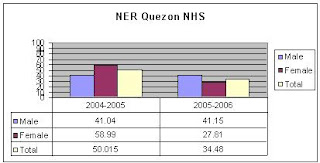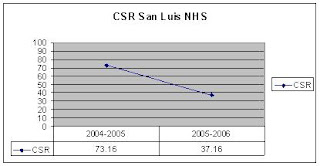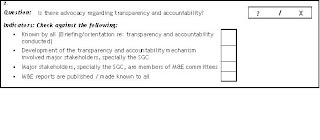
Program Implementation Review 2006 AWP
DIVISION OF BUKIDNON
Section A: How all Sub Project Outputs worked towards the Project Outcome(s)
1. What were the most significant progresses achieved by each of the Sub-projects which contributed to the 2006 Project Outcome?
Sub-project 1 : Capacity building to enhance effectiveness in ensuring quality
education for all.
The activities under the 2006 AWP of the Division of Bukidnon increased the % of teachers trained on CFSS/STS - 3904 out of 4,531 (72%) teachers from 3,195 out of 4,531 (70%) and 253 out of 253 (100%) elementary school heads and 2 out of 45 (4%) of the Secondary School Heads were trained on CFSS/STS. These school heads also improved their supervisory skills after undergoing a series of in-service trainings on supervision, mentoring , SBM and NCBTS . These trainings were focused on aligning all activities in the school to meet the targets set under EFA. The 2006 activities under sub-project 1 were designed to encapsulate all programs and projects as contributory activities in accomplishing the EFA targets by 2015. Hence , the School Improvement Plan (SIP) of the school heads were focused on accomplishing targets in the Performance Indicators such as NER, CSR, and Achievement. Their Instructional Supervisory Plan (ISP) outlined a 3 - teacher per week instructional supervision or a frequency of 12 teachers per month. This frequency would translate into 3,036 (67%) of the teachers observed and supervised in a month in the Division.
Understanding the role of CFSS/STS as an approach in accomplishing EFA targets that includes SBM, NCBTS, SFI, SGC is considered a major impact in accomplishing project outcome which consequently would contribute in the accomplishment of the strategic results outlined in the Log frame of the Basic Education for All Program.
Below is a graphical representation of the Performance Indicator (NER & CSR) of the Division in the last 3 years.

The targeted NER in the 2007 AWP is 87 but the actual accomplishment of the Division is only 73.14. which is 14% shy from the target. This is considered one of the constraints that hampered the accomplishment of the expected outcome under this project.
The NER of Bukidnon decreased over a period of three years mainly because of the peace and order situation in the Province. There are areas in the Province where sporadic conflicts occurred causing some schools to close. It should also be noted that Bukidnon has several agricultural industries and workers constantly move from one place to another looking for work. This seasonal movement of workers also affects the NER of the Division because parents usually brought with them their children as they move from one place to another.





However, although the net enrolment rate is sliding downward, the cohort survival rate seems to increase as shown in the graph. This explains that pupils tend to remain in the school once they get enrolled. Although the NER indicates that lesser pupils are enrolling, those who choose to enroll stayed in the school. This is a good indicator of an improved holding power of the schools. This indicator contributed to the outlined outcome of this sub-project to encourage the children to stay in schools.
Although the CSR slightly increased from the baseline of 50.74 to 54.65, it is still points away shy from the targeted CSR in the AWP 2007 which is pegged at 72%.
As in the case of NER, the targeted performance in CSR is maybe too high, hence unrealistic.
One lesson learned from this constraints is that targets should be set realistically based on existing data. Perhaps in setting targets a good number of data are needed and trends or patterns should be established in order to set a realistic or moderate targets.
Sub-Project 2: Service delivery to meet basic needs of schoolchildren and teachers.
Under Sub-project 2, 40 primary schools and 4 secondary schools were provided with investment packages. This would benefit 24,407 students who were given an opportunity to use the 100-book library and science equipments. 3 primary schools availed of the WASH Project and 1 primary school is in the initial stage of implementing one mode of ADM called e-IMPACT School.
One of the major impact of this sub-project in the attainment of the project outcome is on achievement.
The chart below shows the level of achievement of the Division in the last five (5) years.


The achievement level of the Division is below the targeted 75% level but its trend is increasing over the five-year period. Although the rate of increase is sliding downward its average rate of increase if sustained (logarithmic projection) provides a good chance of hitting the target set by the strategic result by the year 2009 which is 65% mastery level.
Placed side by side, it would literally indicates that if there are lesser pupils in schools these children will basically stay in schools and there is a great tendency for these children to achieve higher in performance tests. Perhaps in theory, but based on the three year period performance of the Division in the three indicators these assumptions seemed to emerge.
Sub-Project 3: Empowerment to enhance participation of children and communities.
In the Division of Bukidnon as well as in all other Divisions in the country, organization of SBOs are institutionalized. This is also true to the PTCAs and LSBs. LSBs and PTCAs played a great role in providing support to the schools in terms of funds augmentation and other activities such as feeding programs, and most specifically on infrastructure support. It should be noted that LSBs and PTCAs are very active in the schools. In fact before CFSS, PTCAs and LSBs are very much involved in its role as partners of education. One major impact of the LSBs and PTCAs support to education in the Division is the establishment of 2 Library Hubs in the Division. These Library Hubs can not be established without infrastructure support. These were provided by the LSBs, LGUs and PTCAs in 2 schools of the Division.
One constraint encountered under this sub-project is the non-implementation of most of the activities outlined in the AWP because of fund release. However, the Division in partnership with other implementing agencies in the Province such as the LPID of the DILG, DSWD, and Communication under PIA, the Division were able to advocate Children’s Rights to 50 student leaders during the Annual Children’s Congress. This activity allowed students to understand their rights and its accompanying responsibilities. In fact as an output, the student leaders were able to craft a resolution on how these rights will be applied in the schools, community and government agencies. The resolution will be submitted to the Sangguniang Panlalawigan for possible adoption.
This is one of the best practices that the Division can be proud of in terms of cross cutting and synergy actions.
Sub-project 4: Monitoring and evaluation at school level to track children's progress.
Activities under this sub-project are not still implemented. Hence no data are available. However funds for this purpose are already released but it has still to be implemented before the end of the year. However, during MANCOM Meetings and other in-service trainings con ducted to all school heads, the Self assessment checklist were given to the school heads. Although the result for this year’s assessment are not yet available , the Division were able to assessed 100% of the schools in the Division.
This is also one of the best practices of the Division : integration and institutionalization of CFSS activities to the regular activities of the Division.
2. What were the lost opportunities or major shortcomings that were encountered in ALL Sub Projects that have been constraints to achieving the 2006 Project Outcome(s)?
One major shortcomings is the non-implementation of the e-IMPACT ADM in one pilot school in the Division. This was due to the late implementation of the capacity building training on instructional delivery and non-provision of the needed support instructional modules. This is one constraint affecting the performance under this project.
Institutionalization of STS is very difficult because the tracking system requires a lot of paper work. Reproduction of the forms alone can become a great burden for the teachers. LSBs and PTCAs do not prioritize this program because they focus more on the infrastructure support and other activities in the school. Hence expenses incurred for the reproduction of the forms alone make it not so popular with the teachers inn addition to a lot of recording that adds up to their heavy load. Funds for the reproduction of the STS forms are not sufficient for all the teachers and are not released immediately. However funds for the reproduction of the STS forms were just recently released hence it was not still implemented. This will be implemented in the last quarter.
The visible constraint of this activity is the reproduction of STS Forms which proved to be too taxing to the teachers and also its recording, the paper work.
2. With reference to Question 2, what impact have these lost opportunities/shortcomings had on the ability to implement the Sub Project/Project in the future?
For the ADM it was not implemented this school year although its target date of operation is on June of 2006. The late capacity building and non-provision of modules left the teachers unable to operate under the ADM Mode.
No sufficient data can be gathered on the impact of STS. Although schools tried their best to come up with data out of the STS forms , however no analysis were done.
Section B: How all Project Outcomes worked towards the Program Strategic Result
1. To what extent did all of the projects contribute to the achievement of the Strategic Result of the program?
Sub-project 1 provided enhanced skills of school heads ,and supervisors on mentoring, school based management and networking which has an impact on the performance of the schools relative to the strategic results on performance. Although there was a decrease of the NER of the schools, interventions for the improvement of this indicator were included and prioritized by the school heads in their School Improvement Plan. (SIP)
Sub-project 2 provided a learning environment where children were given opportunities to enhance their skills and as such contributed to the targeted 65% mastery level of the students. A projected trend on the achievement level of the Division it indicates that it will hit the target in 2009 as provided for in the strategic result. A separate report will be provided in later dates of the feedback of teachers and students on the provision of 100-book library and science equipments given to them.
Sub-project 3 provides for an enhanced understanding on the role of students , parents and the community the quality of education provided in the public schools. Although no data are available of the major contributions of this support environment have on the schools, result of the performance indicators would show that their support have also affected the performance of the Division in terms of NER, CSR and Achievement Rate. Organization of School Governing Councils in the schools and initial actions on the Schools First Initiative are very evident on the SIPs of the school heads. There are indicators that the school heads are now including student leaders , parents and the community in crafting the SIP’s.
Sub-project 4 contributes to the impact of the strategic result by providing feedback to the school heads and teachers on the level of implementation of CFSS and provided them with a framework with which their ISPs and ISPs were anchored. Again, the weaknesses and strengths of the schools in the assessment checklist are analyzed and activities are provided for in their SIP to improve some poor indicators in the checklist.
One of the best practices that the Division is proud of is the action done by key officials because of the result of the M and E. In last year’s result it was found out that in goal No. 2 teachers claimed that the schools did not take care of their general health. Because the percentage of responses was very high, the Superintendent explored the possibility of having medical examination of teachers ( the regular x-ray examination) to be funded by the Provincial School Board. This year teachers enjoyed a free x-ray examination .






































